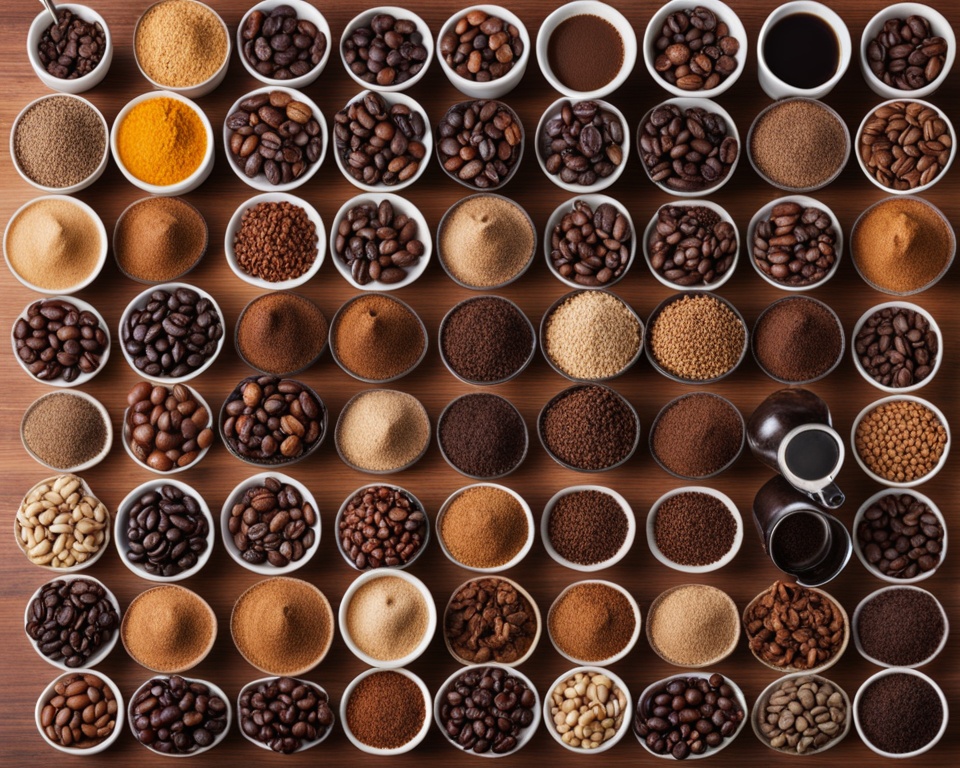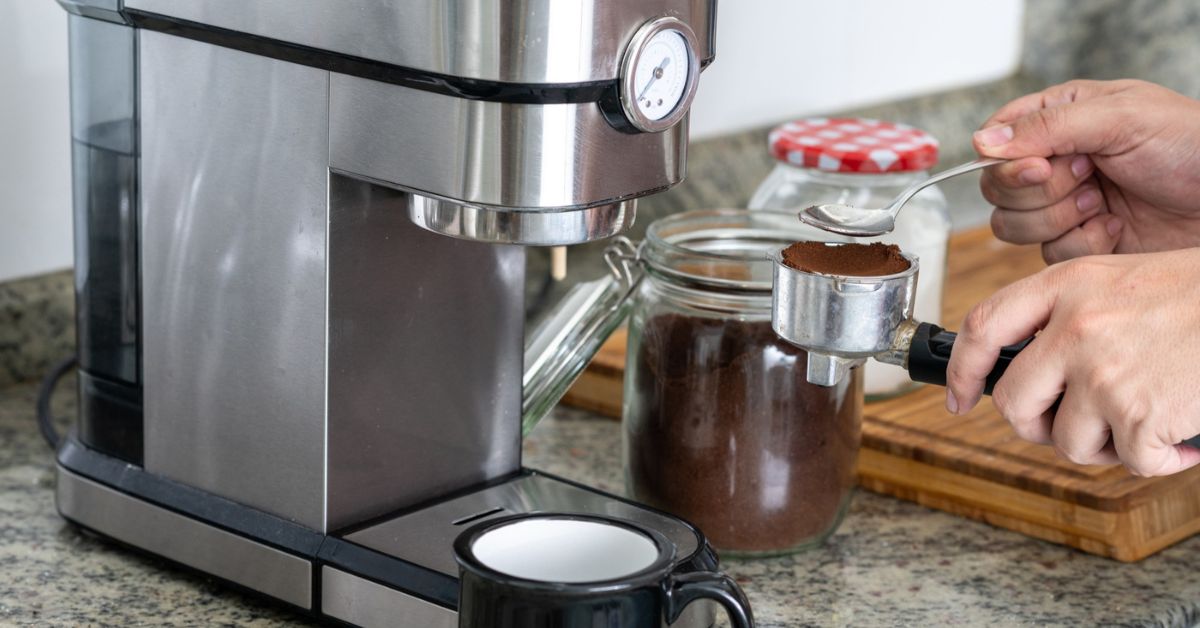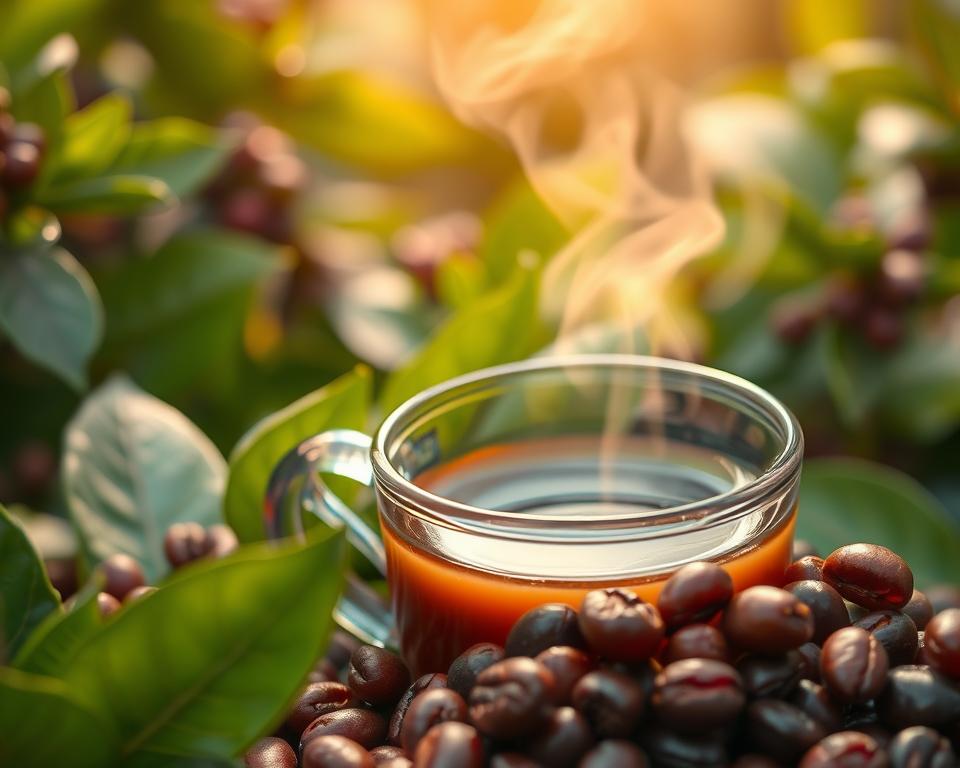Did you know your morning coffee comes from a tropical “bean belt”? This belt runs through countries in Central and South America, Southeast Asia, and Africa. Each place grows different types of coffee. We have Arabica beans, known for their sweet flavour, and Robusta beans, which are bolder.
Exploring coffee has shown me its vast world of tastes, from chocolatey to fruity notes. Each sip shares the story of where it’s from. It invites us to learn about different coffee types, their roasts, and how they’re made.
In my coffee journey, I’ve found that there’s a lot to making a good cup. It can start your day strong or finish it with a gentle espresso. Let’s explore the varieties of coffee together. We’ll see how the beans reflect their origin and the skill involved in making them.
Key Takeaways
- Arabica beans offer a multitude of flavours and represent the majority of coffee production.
- Distinct roasting levels bring out unique aromatic experiences, from light to dark.
- As one wanders through the ‘bean belt’, they can taste the influence of region-specific conditions within each variety.
- Understanding grind size can elevate your brewing technique and enhance your coffee’s final profile.
- Preservation is key—proper storage keeps your coffee fresh and flavorful, maintaining its artisanal quality.
- Popular coffee drinks like lattes and cappuccinos rely on a perfect blend of espresso and steamed milk.
- The choice of espresso machine impacts the quality of your brew, making it an essential consideration for coffee lovers.
Understanding coffee beans and their origins

Coffee beans are crucial for our beloved drink, tied to history and geography. They started in Ethiopia and sub-Saharan Africa, becoming the top seeds of coffee. These beans are more than a caffeine source; they represent their origin, creating popular coffee flavours.
Different Types of Coffee: What Are Coffee Beans?
Arabica and Robusta beans dominate the coffee scene. Arabica is known for its smooth taste, turning every espresso into a story with hints of fruit or nuts.
It travelled from Ethiopian forests to our cups, marking an incredible journey.
Indigenous Roots: Arabica and Robusta
Robusta is Arabica’s bold sibling, known for its strong caffeine kick. Grown in Africa, it gives espresso a full, woody taste. This taste is why many love it.
Deconstructing Bean Varieties: Liberica and Excelsa
Liberica and Excelsa beans add unique flavours to our coffee. Liberica offers a woody scent, while Excelsa has a tart, fruity taste.
They’re for those who love exploring coffee origins.
| Statistic | Arabica | Robusta | Liberica & Excelsa |
|---|---|---|---|
| Caffeine Content | 0.8–1.4% | 1.7–4.0% | Varies |
| Origin | Ethiopia, Latin America | Africa, Southeast Asia | Southeast Asia |
| Consumer Perception | Smooth, sweet | Strong, bold | Unique, rare |
| Industry Value (2023) | $495.50 billion | ||
| Production Share | 60% of world coffee | 30% of world coffee | Minor |
| Notable Regions | Brazil, Colombia | Vietnam, India | Philippines, Malaysia |
Exploring single-origin coffees is like reading a story for every bean. This story includes its birthplace, harvesters, and the cultures that cherished it.
Whether it’s espresso, robust grounds, or filtered coffee, the variety is large and meaningful. Drinking coffee connects us to a diverse, evolving legacy. For enthusiasts, every sip honours the past and anticipates the future.
The Rich Tapestry of Arabica Beans
As a coffee enthusiast, I love Arabica beans for their complex flavors. They are not just a main part of the coffee world. They also carry cultural history and uniqueness. Grown in high-altitude areas, these beans have a distinct acidity and flavour range.
They delight anyone who tries them. Compared to Robusta beans, they have less caffeine. This makes them a favourite for those who enjoy flavour more than a caffeine kick.

- Arabica beans are longer and smoother than Robustas. This appearance suggests the flavours they hold. When ripe, they are handpicked. This shows the dedication to quality coffee.
The cherries turn red or yellow, full of sugars and flavors. Each harvest brings excitement about how these beans will affect coffee roasts. And in turn, our beloved drinks.
- The great Arabica beans have a wide flavour range. You can taste fruity, floral, or chocolaty notes.
- They grow best in specific climates, mostly between 600 and 2,000 metres high. The Andes in Latin America offer these perfect conditions.
- This careful farming results in beans that are perfect for many coffee roasts. Each roast shows different sides of its complex character.
| Characteristic | Description |
|---|---|
| Acidity Level | Ethiopian Arabica: Bright, citric. Latin American Arabica: vibrant, fruity. |
| Body | Medium-bodied coffees are well-rounded. Full-bodied roasts feel rich and indulgent. |
| Bean Appearance | Larger and more elongated than Robusta, they’re noticeably smoother. |
| Flavor Notes | They offer a complex mix of fruit, floral, and citrus. It’s typical in specialty Arabica roasts. |
| Geography | They’re mainly from Colombia, Brazil, Ethiopia, Kenya, and Indonesia, among others. |
| Cultivation Altitude | They do best at 600 to 2,000 meters. Each region influences the final flavor. |
Let’s toast to the next brew we discover. Each sip unfolds more of this aromatic tale.
Unveiling the Robust World of Robusta Beans
I’ve come to appreciate the boldness of Robusta beans in the coffee world. They are affordable and have a hearty flavor. These traits make them stand out in the vast market of coffee blends and coffee roasts.
Let’s explore what makes Robusta unique and how it differs from Arabica.

Characteristics of Robusta Coffee Beans
Robusta’s name says it all—robust. This coffee thrives in tough climates and produces a rich, full-bodied espresso.
It’s a favourite for those who enjoy a thick crema on their espresso. Robusta beans also pack more caffeine, giving espresso that extra punch.
They play a crucial role in crafting various popular coffee types worldwide.
Robusta vs. Arabica: A Comparative Analysis
Robusta and Arabica differ greatly. Arabica from Brazil is sweet and complex, while Robusta from Vietnam is bold and earthy. Unlike Arabica’s delicate, fruity notes, Vietnam’s Robusta offers a chocolatey touch.
This contrast enriches the coffee culture, catering to diverse preferences.
| Characteristic | Arabica | Robusta |
|---|---|---|
| Flavor Profile | Sweet, nuanced, with a hint of acidity | Strong, bold, and chocolaty |
| Caffeine Content | Lower | Higher |
| Ideal Growing Conditions | Cooler altitudes, shaded farms | Warmer climates can thrive at lower altitudes |
| Popular in Coffee Types | Specialty and artisan coffee | Espresso, blends |
How Does Indonesian Coffee Compare to Other Types of Coffee in Terms of Flavor and Brew Methods?
Indonesian coffee varieties stand out for their rich, earthy flavors and unique profiles influenced by volcanic soil. Often brewed using traditional methods like the Sumatran Gayo style or the French press, these coffees offer a robust and smooth experience, contrasting with lighter Central American brews and fruity African options.
The Unique and Rare Liberica Coffee Experience
Liberica beans are not like your everyday coffee. They are rare and have a unique taste. Compared to popular varieties, these beans are something special.
They come from West Africa but are also found in Malaysia and the Philippines. Their bold flavour provides an adventure for the taste buds.
Liberica beans are bigger and asymmetric. They add a smoky flavour to my coffee. Finding them is a treat. They bring woody and floral notes to my cup. This is much different from the common Arabica and Robusta. It shows how diverse the coffee world is.
While not as common as other types, Liberica holds a place in our hearts. For those of us who love unique coffees, it’s a favourite.
The coffee industry is huge, worth billions. But Liberica beans remain a beloved rarity.
FAQ
What Are the Different Types of Coffee Beans?
There are four main coffee bean types: Arabica, Robusta, Liberica, and Excelsa. Arabica beans are sweet and fruity. Robusta beans are stronger, bitter, and have more caffeine. Liberica beans are rare, offering a woody flavor. Excelsa beans are tart and fruity.
What Is the Origin of Coffee Beans?
Coffee beans come from the Coffea plant, starting in Ethiopia and sub-Saharan Africa. Now, they grow in tropical places worldwide. Each area gives the beans unique tastes due to its soil and climate.
Why are Arabica beans so popular?
Arabica beans are loved for their sweet and delicate flavors. They can taste like berries or chocolate, and sometimes they are floral or nutty. Because they’re sweeter and have less caffeine, many specialty coffee fans prefer them.
How Do Robusta Beans Differ from Arabica?
Robusta beans are different in taste, caffeine, and growth. They’re stronger and more bitter, with earthy notes, and have more caffeine. Robusta grows at low altitudes and resists pests well. Arabica needs cooler, higher places to grow, making its flavour more complex.
What makes Liberica beans unique?
Liberica beans stand out due to their unusual taste and size. They have a bold, smoky taste. They’re rare, making them exciting for those who like to try new coffees. You mostly find Liberica in the Philippines and Malaysia.
What Are Artisanal Coffee Options?
Artisanal coffees are specialty brews made in small batches. Every step, from growing to brewing, gets careful attention. These coffees might use single-origin beans or special blends for unique, rich flavours.
What is single-origin coffee?
Single-origin coffee comes from one place, like a specific farm. It’s loved for showing the unique taste of its home’s land and culture.
How do coffee roasts affect flavour?
The roast level changes a coffee’s taste. Light roasts keep the bean’s original traits, offering bright notes. Medium roasts balance acidity and body with caramel flavors. Dark roasts have a strong taste, more body, and notes like chocolate, but less acidity.
Can you recommend any specialty coffee drinks?
Sure! If you love coffee’s subtle tastes, try a pour-over or Chemex. They highlight the delicate flavours, especially of Arabica beans. For a strong taste, choose a ristretto. It’s a short espresso shot. A flat white mixes rich espresso with smooth microfoam milk. Or, explore a single-origin espresso at your local coffee shop for a special taste.




